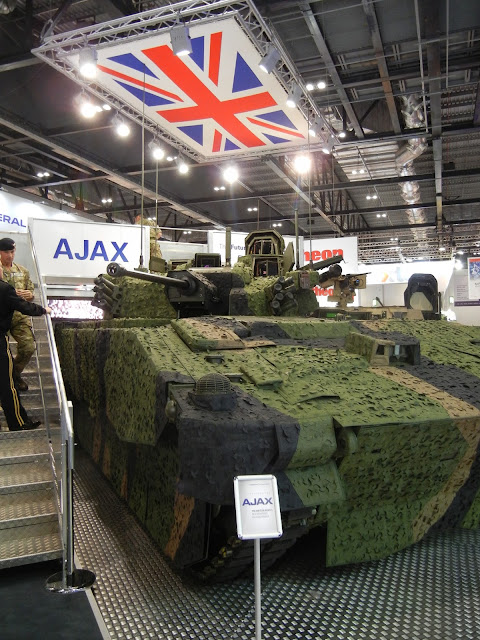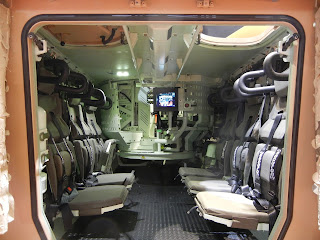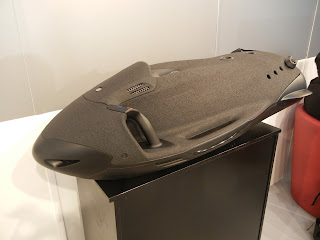On 29 September 2015, at the third German-Japanese Defence Forum in Tokyo by the German Chamber of Commerce and Industry in Japan, 23 German companies and one Japanese company (Fujitsu) exhibit and present their high technology to the Japanese customer.
As reported before, after seven decades of self-imposed exclusion from the international defence market, Japan has opened up to foreign companies. Complemented by a series of lectures on defence technology, i.e. weapons and ammunition, electronics and defence components, and mission support and supply equip,emt, the event has attracted Japanese defence companies and government officials from both countries.
German ambassador Dr. Hans Carl von Werthern provided information about Germany and Japan being natural partners, by both being centres of high technology, having arms-exports restrictions in place, and increasing costs for modern defence equipment. He made an excellent point by stating that Small Sized Enterprises (SME) being the backbone of the defence industry.
In his keynote, Hubert Blahnik, Deputy Director General for Equipment and Usage (AIN) in the German MoD, explained that the Armed Forces need the best equipment possible. As budgets are currently challenging, “we must look for partners,” where Japan comes into place, as both countries (German and Japan) are highly reliable. While the MoDs of both countries are in legal discussions for possible cooperations, it is “largely up to industry to work on practical means for collaboration.”
In February 2015, Japan’s MoD announced that it will establish the Acquisition and Logistics Agency (ATLA), to be headed by a commissioner who has seniority equivalent to an administrative vice minister (the top bureaucratic position), and is expected to absorb the Japanese MoD’s resident research and development (R&D) and contract management functions. By doing so, this new organisation is expected to provide oversight in five core functions: Acquisition programme management, promotion of defence equipment cooperation with Japan’s trusted security partners, R&D, execution of acquisition reform, and preservation of Japan’s indigenous defence industrial base. The official launch is expected in the next few days.
Toru Hotchi, Director of Equipment Policy Division, Bureau of Finance and Equipment, Japanese MoD told the forum of industry experts and military that advice from German MoD and industry on how to integrate SMEs into the fold can be used. With challenging financial difficulties, ATLA is bound to further accelerate working level discussions on transfer of technology with Germany and expand it around the world. “We need to have international partnerships,” he said.
To further German-Japanese defence industry cooperation, Akiko Iimura, Director for Defence Industry, Ministry of Economy, Trade and Industry (METI), gave an outlook of the future vision of the Japanese Defence Industry: Maintain and strengthen the industry base, and to maintain and enhance technology superiority through R&D, with Japan being either a partner or supplier or both.
As one of the companies exhibiting at the forum, Dynamit-Nobel (DND) told MT that the company is here to promote its new RGW 90 family, as well as its family of DynaSim simulators. Renowned manufacturer of shoulder launched munitions (SLM), DND has been introducing a series of variants of its well proven RGW 90 weapon including an area denial munition. At the DND presentation, the company detailed its ERA solution that is on order for the German Army's new PUMA vehicle. DND's head of business development Herbert Weisshaupt explained that while DND has been working on ERA solutions for many years, recent trials have shown that its ERA protective system is capable of coping with hits of small and medium caliber rounds up to 30mm including APFSDT rounds without going off.
RUAG is at the forum in order to further promote its DO228 robust turboprop aircraft, having already sold five to NCA and a 6th in the works.
Airbus Defence & Space (DS) and Fujitsu detailed their cooperation in the ATX Japanese military trainer aircraft future tender, electronic warfare systems, and missile warners. In terms of gallium-nitride (GaN), Fujitsu is a world leader, and Airbus DS wants to use this expertise for possible future markets.
"The reason we are here is, primarily, to simply get to know a lot more about the market, to find out its potential for our company and present ourselves to firms that could become our clients or collaborators," a Jenoptik executive told MT. In news, he unveiled to MT that the company has recently sold NYXUS BIRD multifunctional thermal imager to the Police of Peru.
Rheinmetall, having already provided the Japanese military with munition and smoothbore guns, the group is currently in tests with its F-35 onboard cannon munition, and will market this in Japan, once tests are finalised.
TKMS is at the moment watching the marketplace very closely.
Atlas Elektronik provides an array of maritime solutions, including sonar, command and weapons deployment systems, mine countermeasures equipment, unmanned underwater and surface craft and shipping guidance systems, with a lot of interest here in Japan.
The Forum is still on today, so please watch this place for news from the floor and conference, as well as our twitter feed.
As reported before, after seven decades of self-imposed exclusion from the international defence market, Japan has opened up to foreign companies. Complemented by a series of lectures on defence technology, i.e. weapons and ammunition, electronics and defence components, and mission support and supply equip,emt, the event has attracted Japanese defence companies and government officials from both countries.
German ambassador Dr. Hans Carl von Werthern provided information about Germany and Japan being natural partners, by both being centres of high technology, having arms-exports restrictions in place, and increasing costs for modern defence equipment. He made an excellent point by stating that Small Sized Enterprises (SME) being the backbone of the defence industry.
In his keynote, Hubert Blahnik, Deputy Director General for Equipment and Usage (AIN) in the German MoD, explained that the Armed Forces need the best equipment possible. As budgets are currently challenging, “we must look for partners,” where Japan comes into place, as both countries (German and Japan) are highly reliable. While the MoDs of both countries are in legal discussions for possible cooperations, it is “largely up to industry to work on practical means for collaboration.”
In February 2015, Japan’s MoD announced that it will establish the Acquisition and Logistics Agency (ATLA), to be headed by a commissioner who has seniority equivalent to an administrative vice minister (the top bureaucratic position), and is expected to absorb the Japanese MoD’s resident research and development (R&D) and contract management functions. By doing so, this new organisation is expected to provide oversight in five core functions: Acquisition programme management, promotion of defence equipment cooperation with Japan’s trusted security partners, R&D, execution of acquisition reform, and preservation of Japan’s indigenous defence industrial base. The official launch is expected in the next few days.
Toru Hotchi, Director of Equipment Policy Division, Bureau of Finance and Equipment, Japanese MoD told the forum of industry experts and military that advice from German MoD and industry on how to integrate SMEs into the fold can be used. With challenging financial difficulties, ATLA is bound to further accelerate working level discussions on transfer of technology with Germany and expand it around the world. “We need to have international partnerships,” he said.
To further German-Japanese defence industry cooperation, Akiko Iimura, Director for Defence Industry, Ministry of Economy, Trade and Industry (METI), gave an outlook of the future vision of the Japanese Defence Industry: Maintain and strengthen the industry base, and to maintain and enhance technology superiority through R&D, with Japan being either a partner or supplier or both.
As one of the companies exhibiting at the forum, Dynamit-Nobel (DND) told MT that the company is here to promote its new RGW 90 family, as well as its family of DynaSim simulators. Renowned manufacturer of shoulder launched munitions (SLM), DND has been introducing a series of variants of its well proven RGW 90 weapon including an area denial munition. At the DND presentation, the company detailed its ERA solution that is on order for the German Army's new PUMA vehicle. DND's head of business development Herbert Weisshaupt explained that while DND has been working on ERA solutions for many years, recent trials have shown that its ERA protective system is capable of coping with hits of small and medium caliber rounds up to 30mm including APFSDT rounds without going off.
RUAG is at the forum in order to further promote its DO228 robust turboprop aircraft, having already sold five to NCA and a 6th in the works.
Airbus Defence & Space (DS) and Fujitsu detailed their cooperation in the ATX Japanese military trainer aircraft future tender, electronic warfare systems, and missile warners. In terms of gallium-nitride (GaN), Fujitsu is a world leader, and Airbus DS wants to use this expertise for possible future markets.
"The reason we are here is, primarily, to simply get to know a lot more about the market, to find out its potential for our company and present ourselves to firms that could become our clients or collaborators," a Jenoptik executive told MT. In news, he unveiled to MT that the company has recently sold NYXUS BIRD multifunctional thermal imager to the Police of Peru.
Rheinmetall, having already provided the Japanese military with munition and smoothbore guns, the group is currently in tests with its F-35 onboard cannon munition, and will market this in Japan, once tests are finalised.
TKMS is at the moment watching the marketplace very closely.
Atlas Elektronik provides an array of maritime solutions, including sonar, command and weapons deployment systems, mine countermeasures equipment, unmanned underwater and surface craft and shipping guidance systems, with a lot of interest here in Japan.
The Forum is still on today, so please watch this place for news from the floor and conference, as well as our twitter feed.











































































